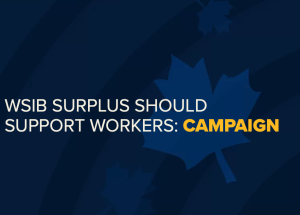工作權立法
名為「工作權立法」實應稱作「低工資的權利」
現今許多工作給予「中產階級」的薪資在過去都是低工資的工作。這包括各種行業,例如,教學、製造業、醫療保健及社會工作等。在這些行業的工人盡力提高他們的薪資標準和工作條件,是勞工運動的傳統。工人通過集體力量組織工會以改善生活。其他工會談判的傳統是我們現正享受的社會政策──醫療保健、退休金、失業保險、工人賠償、有薪假期、產假和最低工資。
但是,富有的企業已認定,年輕一代的加拿大人的價值是低於他們的上幾代。我們已經見到,在我們周圍苦苦掙扎的年輕工人。年輕人現在被提供兩層工資架構、較低的福利,以及沒有希望得到保障的退休金。
為了提高他們的控制,企業希望把所謂的「工作權立法」引進到加拿大。這個建議是,讓有工會的工作場所的工人可以「選擇」是否繳納工會費,而又可以享受由工會努力爭取來的福利。這跟工人的「選擇」並沒有關係,而是大企業想要削弱工人的談判力量,以製造廉價勞動力資源。
很多有工會的工人認為他們現有的工資標準和福利是理所當然的,他們相信公司所付給的是正常運作的一部分, 而不是過往爭取的成果。這需要在大多倫多地區廣泛舉行大量的歷史講座,以解釋集體權利如何為所有人提高生活水準。儘管勞工運動帶領贏得最低工資時薪增加到10.25元,但是現今仍有不少工人的時薪僅僅高於最低工資的規定。
這個所謂「工作權立法」只是為僱主提供僱用更多低工資工人的機會。這不是我們想要的加拿大或我們所應得的。勞工議會將在3月2日展開主要活動,以應對這一威脅。可以前往www.labourcouncil.ca了解更多。
名为「工作权立法」实应称作「低工资的权利」
现今许多工作给予「中产阶级」的薪资在过去都是低工资的工作。这包括各种行业,例如,教学、制造业、医疗保健及社会工作等。在这些行业的工人尽力提高他们的薪资标准和工作条件,是劳工运动的传统。工人通过集体力量组织工会以改善生活。其他工会谈判的传统是我们现正享受的社会政策──医疗保健、退休金、失业保险、工人赔偿、有薪假期、产假和最低工资。
但是,富有的企业已认定,年轻一代的加拿大人的价值是低于他们的上几代。我们已经见到,在我们周围苦苦挣扎的年轻工人。年轻人现在被提供两层工资架构、较低的福利,以及没有希望得到保障的退休金。
为了提高他们的控制,企业希望把所谓的「工作权立法」引进到加拿大。这个建议是,让有工会的工作场所的工人可以「选择」是否缴纳工会费,而又可以享受由工会努力争取来的福利。这跟工人的「选择」并没有关系,而是大企业想要削弱工人的谈判力量,以制造廉价劳动力资源。
很多有工会的工人认为他们现有的工资标准和福利是理所当然的,他们相信公司所付给的是正常运作的一部分, 而不是过往争取的成果。这需要在大多伦多地区广泛举行大量的历史讲座,以解释集体权利如何为所有人提高生活水准。尽管劳工运动带领赢得最低工资时薪增加到10.25元,但是现今仍有不少工人的时薪仅仅高于最低工资的规定。
这个所谓「工作权立法」只是为雇主提供雇用更多低工资工人的机会。这不是我们想要的加拿大或我们所应得的。劳工议会将在3月2日展开主要活动,以应对这一威胁。可以前往www.labourcouncil.ca了解更多。
Right to Work Legislation should really be called “Right to Lower Wages”
Most jobs today that provide “middle class” incomes were once poverty wage jobs. That includes occupations as diverse as teaching, manufacturing, healthcare and social work. The ability of workers in each of those sectors to improve their standard of income and working conditions is the legacy of the labour movement. By standing as a collective, workers formed unions and improved their livelihoods. Other legacies of union bargaining are the social policies we all enjoy today – healthcare, pensions, unemployment insurance, workers compensation, paid holidays, maternity leave and a minimum wage.
But rich business owners have now decided that the next generation of Canadians are worth less than those who came before. We can already see struggling young workers all around us. Young people are being offered 2-tier wage structures, lower benefits, and no hope of a secure pension.
To increase their control, business hopes to import so-called Right to Work legislation into Canada. The proposal is that workers in a unionized workplace have a “choice” about whether they pay union dues, while still enjoying the benefits brought through union efforts. This is not really about workers choice, but the desire of corporations to weaken workers’ bargaining power in order to create a cheap labour pool.
Many unionized workers take the level of wages and benefits for granted, believing that the company gives these things as part of normal practice, rather than the result of past struggle. There needs to be a massive history lesson undertaken across the GTA, explaining how collective rights have been essential in raising the standard of living for all. Although the labour movement led and won the fight to increase the minimum wage to $10.25, there are many people today who are working but barely making above the minimum wage.
This so-called “right-to-work” legislation would only provide employers with increased access to more people working for poverty wages. That’s not the kind of Canada we want, or deserve. On March 2nd Labour Council will launch a major campaign to respond to this threat. Find out more at www.labourcouncil.ca
cope343





